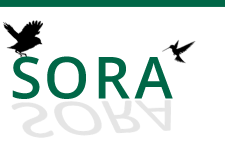Abstract
A fin de conocer la diversidad de aves que utilizó el Paso de Portachuelo durante la campaña de anillado 2015 y analizar su variación con respecto a campañas anteriores, se realizaron muestreos con redes de neblina (5.538 horas/redes) durante 50 días consecutivos entre Septiembre–Octubre de 2015. En la campaña 2015, se registraron 137 especies, 127 de las cuales fueron capturadas y 10 observadas. En total se realizaron 2.337 capturas (de las cuales 571 son de Trochilidae, y 72 Psittacidae) y se anillaron por primera vez 1.279 individuos. Asimismo, se recapturaron 390 aves anilladas en años anteriores. Se registraron 127 especies, de las cuales 19 fueron aves migratorias (17 neárticas, dos australes), 18 colibríes (Trochilidae) y 90 otras especies residentes. La especies con el mayor número de recapturas fueron: el Trepador Marrón Dendrocincla fuliginosa con 16,7% de las recapturas totales, seguido por el Bobito Rayado Mionectes olivaceus y el Curruñata Azulejo Euphonia xanthogaster, ambos con un 15,2%. En cuanto a migratorios, la especie dominante fue la Reinita de Charcos Parkesia noveboracensis, seguida por la Candelita Migratoria Setophaga ruticilla y la Paraulata Cachetona Catharus fuscescens. De la Reinita Rayada S. striata sólo hubo una captura. Se capturaron dos especies migratorias australes durante la temporada de la migración boreal, algo nunca antes registrado para el Paso de Portachuelo: el Bobito Copetón Pico Corto Elaenia parvirostris y el Bobito Escandaloso E. strepera. En cuanto a especies residentes raras con cuatro o menos registros de capturas desde 1990, se capturaron ocho especies, las cuales corresponden a: el Cardenal Avispero Piranga lutea, el Curruñatá Piquigordo Euphonia laniirostris, el Hormiguero Cuascá Chamaeza campanisona, el Campanero Herrero Procnias averano, el Diamante Gargantiverde Amazilia fimbriata, el Mirlo Pico Anaranjado Catharus aurantiirostris, el Atrapamoscas de Sotobosque Lathrotriccus euleri y el Verderón Luisucho Pachysylvia aurantiifrons.
In order to know the bird diversity that made use of the Portachuelo Pass during the 2015 banding season, as well as to analyze bird variation (richnees, abundance) compared to previous campaigns, sampling with mist-nets (5,538 hours/ nets) was carried out during 50 consecutive days between September-October 2015. In the 2015 campaign, 137 species were recorded, 127 of which were captured, and ten observed. From them, 19 species correspond to migratory birds (17 boreal, two austral), 18 hummingbirds (Trochilidae) and 90 other resident species. A total of 2,337 captures (including 571 Trochilidae, 72 Psittacidae) were made and 1,279 individuals were banded for first time. In addition, 390 birds were recaptured, banded in previous years. The species with the greatest number of recaptures were: the Plain-brown Woodcreeper Dendrocincla fuliginosa (16.7% of the total recaptures), followed by the Olive-striped Flycatcher Mionectes olivaceus (15.2%) and the Orange-bellied Euphonia Euphonia xanthogaster (15.2%). As for migratory species, the dominant species was the Northern Waterthrush Parkesia noveboracensis, followed by the American Redstart Setophaga ruticilla, and the Veery Catharus fuscescens. Only one Blackpoll Warbler Setophaga striata got caught, an abundant species in previous campaigns. Two austral migratory species were captured during the boreal migration season: the Small-billed Elaenia Elaenia parvirostris, and the Slaty Elaenia E. strepera; the later never previously recorded for the Portachuelo Pass. As for rare resident species (with four or fewer catches since 1990), eight species were captured: the Tooth-billed Tanager Piranga lutea, the Thick-billed Euphonia Euphonia laniirostris, the Shorttailed Antthrush Chamaeza campanisona, the Bearded Bellbird Procnias averano, the Glittering-throated Emerald Amazilia fimbriata, the Orange-billed Nightingale-Thrush Catharus aurantiirostris, the Euler’s Flycatcher Lathrotriccus euleri, and the Golden-fronted Greenlet Pachysylvia aurantiifrons.
Creative Commons License
Recommended Citation
Lentino, Miguel
(2016)
"Migración en Rancho Grande: Resultados del programa de monitoreo de la migración de aves en el Parque Nacional Henri Pittier, 2015 / Bird Migration at Rancho Grande: Results of the Bird Migration Monitoring Program in Henri Pittier National Park, 2015,"
Revista Venezolana de Ornitología: Vol. 6
:
Iss.
1
, Article 4.
Available at:
https://digitalcommons.usf.edu/rvo/vol6/iss1/4

